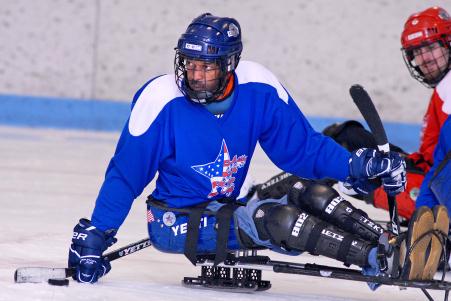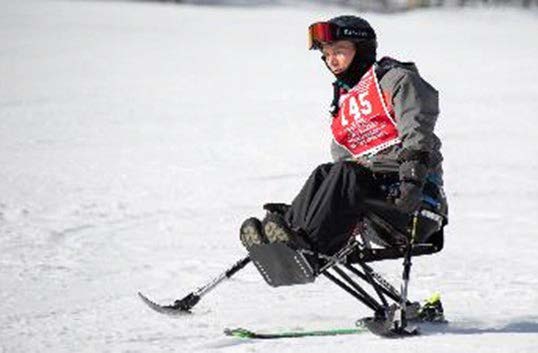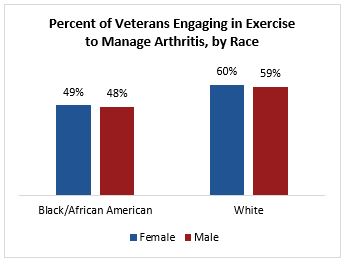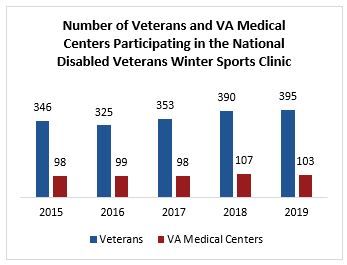Office of Health Equity
Racial and Ethnic Differences in Exercise Use & National Disabled Veteran Winter Sports Clinic
Racial and Ethnic Differences in Exercise Use & National Disabled Veterans Winter Sports Clinic
|
 |
Download PDF
INTRODUCTION
The Veterans Health Administration (VHA) serves a Veteran population that is increasingly diverse. Equitable access to high-quality care for all Veterans is a major tenet of the VA healthcare mission. The Office of Health Equity (OHE) champions the elimination of health disparities and achieving health equity for all Veterans.
The Center for Health Equity Research and Promotion (CHERP) focuses on improving the quality and equity of health and healthcare for vulnerable Veterans. OHE and CHERP have partnered to design reporting tools to disseminate information about health disparities among Veterans at national, regional, and local levels paying special attention to whether gender, geographical location, or individuals that are members of minority population groups experience disparities in care
HEALTH DISPARITIES
Exercise is the single most powerful mode of preventing many chronic conditions, including heart disease and diabetes. Exercise is also used as an effective treatment for managing arthritis – an incredibly burdensome chronic pain condition, affecting over 1 in 5 of all US adults. Arthritis is a major source of disability, causing more functional limitations than heart disease or diabetes. There are differences in which groups of Veterans are likely to engage in exercise to treat their arthritis symptoms. Specifically, baseline data from a VA-funded clinical trial testing a behavioral intervention for arthritis pain found that women and African American Veterans with arthritis are less likely to exercise than other Veteran groups.
REDUCING DISPARITIES
The Office of Health Equity supports efforts across VA working to reduce health disparities by targeting interventions aimed at Veteran groups at higher risk for poor health outcomes.
In the United States, approximately 1 in 5 people have a disability. Nearly half of all adults with disabilities don’t engage in any aerobic physical activity, such as walking, biking, or wheelchair athletics. When targeting interventions aimed at groups that are less likely to be physically active, it is important to culturally tailor exercise recommendations and for clinicians to try to explore an individual’s preferences for physical activities when counseling.
VA’s Office of National Veterans Sports Programs and Special Events provides Veterans with opportunities for health and healing through adaptive sports and therapeutic art programs. These specialized rehabilitation events aim to optimize Veterans’ independence, community engagement, well-being, and quality of life. The programs are built on clinical expertise within VA, with essential support from Veteran Service Organizations, corporate sponsors, individual donors and community partners.
The National Disabled Veterans Winter Sports Clinic is the largest rehabilitative program of its kind in the world today. It utilizes adapted physical activities as well as workshops and educational sessions to aid in the rehabilitation of severely disabled veterans. Activities such as Alpine and Nordic skiing, Snowmobiling, scuba diving, fly fishing, wheelchair golf, wheelchair self defense, rock wall climbing, sled hockey, trap shooting, blues harmonica instruction, dog sledding, goal ball for the visually impaired, wheelchair fencing and amputee volleyball, are a small portion of adapted sports and activities that have been offered in the past 20 years.
For more information about the Office of Health Equity visit: https://www.va.gov/healthequity/
For additional OHE information briefs and fact sheets visit: https://www.va.gov/HEALTHEQUITY/Publications_and_Research.asp
REFERENCES
Hausmann et al. “Effect of a Positive Psychological Intervention on Pain and Functional Difficulty Among Adults With Osteoarthritis: A Randomized Clinical Trial.” JAMA Network Open. 2018; 1(5):e182533 [PMCID: PMC6324470]
Centers for Disease Control and Prevention. Physical Activity is for Everybody. https://www.cdc.gov/features/physical-activity-disabilities/index.html





















